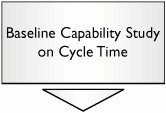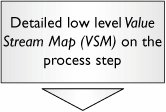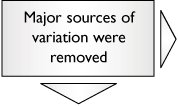Section 3. Too Much Variation in the Cycle Time of a Single Step
3. Too Much Variation in the Cycle Time of a Single StepOverviewProcesses are required to cycle at a fast enough rate to generate entities at a pace to meet customer (or market) demand. Takt Time represents the pace of customer (or market) demand. For more details see "TimeTakt Time" in Chapter 7, "Tools." Even if, on average, the Cycle Time (the actual rate of processing entities) of the process is shorter than the Takt Time and the process on average meets demand, the Cycle Time could be variable enough that in the short term it does not meet Takt and thus affects delivery performance. See also "TimeGlobal Process Cycle Time" in Chapter 7. This category infers that some work has been done to relate the Takt Time to the Cycle Time. If this is not the case, then return to Chapter 3 to select the Problem Category for the process as a whole. Measuring PerformanceThe measures used should have been put in place at the Global Problem Category level, but if not, then use the Process Cycle Time as the metric, calculating both its mean and standard deviation (the aim being to reduce both). Tool ApproachIf this hasn't already been done at a previous step, then:
Even though we often consider a process step of this type to be the smallest, indivisible unit of a process, there are usually sub-steps within each step. It is often within these sub-steps that there are NVA activities causing the variability in Cycle Time.
From the VSM, identify actions to remove any NVA activity from the process step. It is less likely to encounter variability in the VA portion of a step than in the NVA elements, so reduction of NVA activity usually significantly reduces variation in Cycle Time.
The roadmap to solution from here on relies on the equation Y=f(X1, X2,..., Xn), where the Ys are the Cycle Time and the Primary Performance characteristic(s) of the process. For instance, if in a chemical production process we are interested in the assay of the product as a Primary Performance characteristic, then the Ys are assay and Cycle Time. Go to Section C in Chapter 3 and focus on this single process step to determine which Xs can be manipulated to gain the best level of performance for the Ys (including Cycle Time) and minimize the variability. |
EAN: 2147483647
Pages: 138



